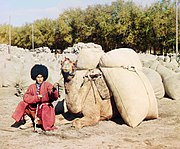Camel: Difference between revisions
m Reverted edits by 84.9.28.71 (talk) to last version by Peterdownunder Tag: Rollback |
Tags: Mobile edit Mobile web edit |
||
| Line 42: | Line 42: | ||
=== Diet === |
=== Diet === |
||
n the desert, people feed camels with [[grass]], [[grains]], [[wheat]] and [[oats]]. When camels are travelling in the desert, food is often very hard to find. So the animal might have to live on dried leaves, [[seeds]], and [[Spine (botany)|thorny]] [[twig]]s (without hurting their mouths). If there is not any regular food, camels will eat anything:, [[leather]], even their owner's [[tent]]. |
|||
=== Digestion === |
=== Digestion === |
||
Revision as of 12:57, 12 June 2019
| Camel Temporal range: [1]
| |
|---|---|

| |
| Bactrian camel (Camelus) | |
| Scientific classification | |
| Domain: | Eukaryota |
| Kingdom: | Animalia |
| Phylum: | Chordata |
| Class: | Mammalia |
| Order: | Artiodactyla |
| Family: | Camelidae |
| Tribe: | Camelini |
| Genus: | Camelus Linnaeus, 1758 |
| Species | |
| Synonyms | |
Camels are a mammal of the Camelidae family. Camels form the genus Camelus. They are also called Afro-Asiatic Camelids. There are two living species of camels. Camels have existed on Earth since prehistoric times.[2]
Habitat and adaptation

Camels live in deserts, where it is hot and dry. Camels have adapted and found ways to help them survive in deserts. They have a thick coat of hair that protects them from the sun. They have wide, soft feet, so they can walk for a long time in the hot sand.
Several adaptations help a camel live in a desert . Their large feet spreads their weight on the sand when they are walking. When there is food and water, a camel can eat and drink large amounts of it and store it as fat in the hump. Then, when there is no food or water, the camel uses the fat for energy, and the hump becomes small and soft. A camel’s waste contains very little water. Even the water from the camel’s breath flows back into its mouth.The camels have bushy eyebrows that don't let the sand go in their eyes in a sandstorm. It has a long slender neck in order to reach high leaves such as palm trees, and rubbery patches on the belly and knees to protect the skin when kneeling and sitting on the hot sand. These form after five years of age.
A camel has a naturally adapted temperature regulation - it can change its bodily temperature by six degrees Celsius either way. It has two sets of eyelashes, closing muscles in the nasal passages with slited nostrils, hairy ears and tough, leathery skin to protect the camels skin in vital emergencies such as a sandstorm. It has thick rubbery lips to eat dry, prickly plants and a large, haired tail to swat pests such as mosquitos and flies.
The toes are large black, which help it to jump in the deep desert sand. There are two types of camels: the Dromedary and the Bacterian. The dromedary has one hump while the bacterian has two.[3]
Life

Camels live in groups, with one male, several females, and their young calves.
Reproduction
An unborn camel gestates about 9 to 11 months. There is usually one calf per birth. A camel calf can run only a few hours after it is born. Calves are weaned when they are about 1 year old.
Diet
n the desert, people feed camels with grass, grains, wheat and oats. When camels are travelling in the desert, food is often very hard to find. So the animal might have to live on dried leaves, seeds, and thorny twigs (without hurting their mouths). If there is not any regular food, camels will eat anything:, leather, even their owner's tent.
Digestion
Camels are ruminants but camels do not chew their food very well before swallowing. The first stomach stores the food that is not completely chewed. Later, this food (or cud) returns to the camel's mouth, and the camel chews it again. Then the camel swallows the cud and it goes to the other parts of the stomach to be completely digested.
Camels and humans

Camels have been domesticated by humans for about 5000 years. They are used for riding and to carry things, and for meat, milk and wool.
As domesticated animals they are used in Africa, Asia, and since the 19th century also in Australia. About 900-1000 wild Bactrian Camels still live in China and Mongolia. There are no wild Dromedaries anymore, but there are escaped domestic Dromedaries in Australia. Today there are about 50,000 Dromedaries living wild in the Outback in Australia.
A Dromedary and a Bactrian Camel can have hybrid children that are called Tulus or Bukhts. These hybrids are larger than the Dromedary or Bactrian Camel and have either one long hump or one small and one big hump.
When a camel calf reaches one year of age, the owner often teaches it to stand and kneel on command. They also learn to carry small, light packs around. As they grow older, the size of the pack also increases.
Gallery
-
Bactrian camel
-
Bactrian Camel
-
Dromedary
-
A Turkmen man with his dromedary, circa 1905-1915 in Turkmenistan.
-
Two camels used for riding.
References
- ↑ http://fossilworks.org/bridge.pl?a=taxonInfo&taxon_no=42521.
{{cite web}}: Missing or empty|title=(help) - ↑ Canada’s North, Home to Bears, and Once, Camels March 5, 2013 New York Times
- ↑ "Ducksters: Education Site". www.ducksters.com. Retrieved 2019-02-01.




